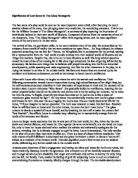In the play, The Glass Menagerie, Scene One provides an insight into the events yet to come. It introduces the Wingfield family, giving a clear description of their lifestyle and personal behaviours. The Wingfield apartment is described as a small unit in an overcrowded and dirty urban slum. Visible outside is a fire escape, which holds symbolic weight, as it illustrates Tom’s desperation for escape. He says that the buildings are burning with the "implacable fires of human desperation."
Tom is the narrator of the play and is first seen dressed as a merchant sailor. He informs the audience as to the period in which the play is set, that is the thirties. This helps the audience to better understand and relate to the events to come, and gives an idea of the state of the economy at that time; during the thirties in America, there was great turmoil, and the economy was crumbling. He explains that the play is based on memory and therefore has certain unrealistic qualities about it, including the music and the sentimental lighting. Tom also introduces the other characters; his mother Amanda, his sister Laura, the gentleman caller who will appear later on in the play, and of course their father, the ever absent character who is only seen in a large smiling photograph on the living room wall.







